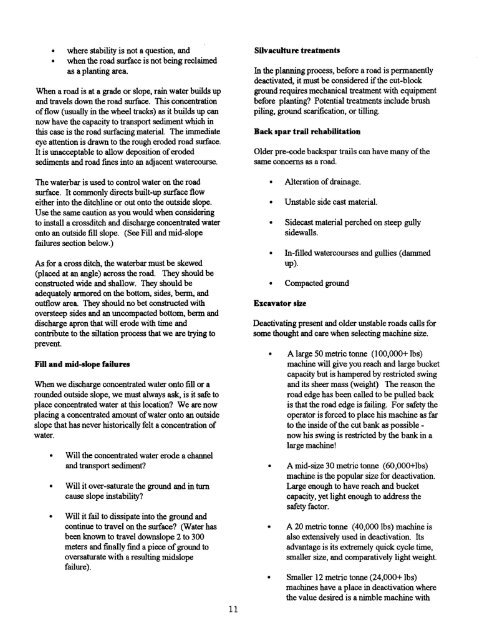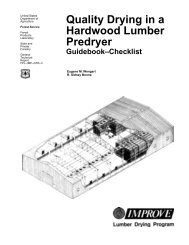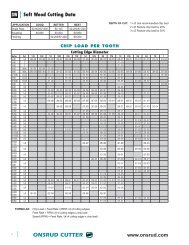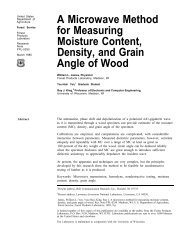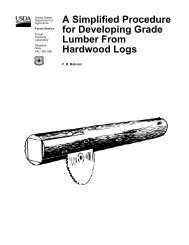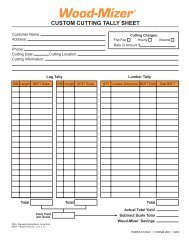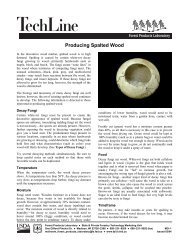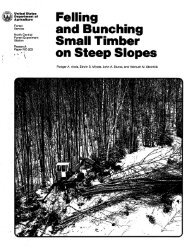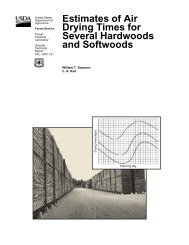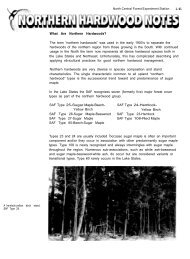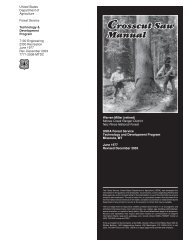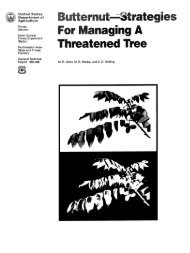Planning and implementing forest operations to achieve ... - Woodweb
Planning and implementing forest operations to achieve ... - Woodweb
Planning and implementing forest operations to achieve ... - Woodweb
You also want an ePaper? Increase the reach of your titles
YUMPU automatically turns print PDFs into web optimized ePapers that Google loves.
• where stability is not a question, <strong>and</strong> Silvaculture treatments<br />
• when the road surface is not being reclaimed<br />
as a planting area.<br />
In the planning process, before a road is permanently<br />
deactivated, it must be considered if the cut-block<br />
When a road is at a grade or slope, rain water builds up ground requires mechanical treatment with equipment<br />
<strong>and</strong> travels down the road surface. This concentration<br />
before planting? Potential treatments include brush<br />
of flow (usually in the wheel tracks) as it builds up can piling, ground scarification, or tilling.<br />
now have the capacity <strong>to</strong> transport sediment which in<br />
this case is the road surfacing material. The immediate Back spar trail rehabilitation<br />
eye attention is drawn <strong>to</strong> the rough eroded road surface.<br />
It is unacceptable <strong>to</strong> allow deposition of eroded<br />
Older pre-eode backspar trails can have many of the<br />
sediments <strong>and</strong> road frees in<strong>to</strong> an adjacent watercourse, same concerns as a road.<br />
The waterbar is used <strong>to</strong> control water on the road . Alteration of drainage.<br />
surface. It commonly directs built-up surface flow<br />
either in<strong>to</strong> the ditchline or out on<strong>to</strong> the outside slope. • Unstable side cast material.<br />
Use the same caution as you would when considering<br />
<strong>to</strong> install a crossditch <strong>and</strong> discharge concentrated water • Sidecast material perched on steep gully<br />
on<strong>to</strong> an outside fill slope. (See Fill <strong>and</strong> mid-slope sidewalls.<br />
failures section below.)<br />
• In-filled watercourses <strong>and</strong> gullies (dammed<br />
As for a cross ditch, the waterbar must be skewed<br />
up).<br />
(placed at an angle) across the road. They should be<br />
constructed wide <strong>and</strong> shallow. They should be • Compacted ground<br />
adequately armored on the bot<strong>to</strong>m, sides, berm, <strong>and</strong><br />
outflow area. They should no bet constructed with<br />
Excava<strong>to</strong>r size<br />
oversteep sides <strong>and</strong> an uneompacted bot<strong>to</strong>m, berm <strong>and</strong><br />
discharge apron that will erode with time <strong>and</strong><br />
Deactivating present <strong>and</strong> older unstable roads calls for<br />
contribute <strong>to</strong> the siltation process that we are trying <strong>to</strong> some thought <strong>and</strong> care when selecting machine size.<br />
prevent.<br />
• A large 50 metric <strong>to</strong>nne (100,000+ lbs)<br />
Fill <strong>and</strong> mid-slope failures<br />
machine will give you reach <strong>and</strong> large bucket<br />
capacity but is hampered by restricted swing<br />
When we discharge concentrated water on<strong>to</strong> fill or a <strong>and</strong> its sheer mass (weight) The reason the<br />
rounded outside slope, we must always ask, is it safe <strong>to</strong><br />
road edge has been called <strong>to</strong> be pulled back<br />
place concentrated water at this location? We are now is that the road edge is failing. For safety the<br />
placing a concentrated amount of water on<strong>to</strong> an outside<br />
opera<strong>to</strong>r is forced <strong>to</strong> place his machine as far<br />
slope that has never his<strong>to</strong>rically felt a concentration of <strong>to</strong> the inside of the cut bank as possible -<br />
water,<br />
nowhisswingisrestrictedbythebankina<br />
large machine!<br />
• Will the concentrated water erode a channel<br />
<strong>and</strong> transport sediment? * A mid-size 30 metric <strong>to</strong>nne (60,000+lbs)<br />
machine is the popular size for deactivation.<br />
• Will it over-saturate the ground <strong>and</strong> in turn Large enough <strong>to</strong> have reach <strong>and</strong> bucket<br />
cause slope instability?<br />
capacity, yet light enough <strong>to</strong> address the<br />
safety fac<strong>to</strong>r.<br />
• Will it fail <strong>to</strong> dissipate in<strong>to</strong> the ground <strong>and</strong><br />
continue <strong>to</strong> travel on the surface? (Water has * A 20 metric <strong>to</strong>nne (40,000 lbs) machine is<br />
been known <strong>to</strong> travel downslope 2 <strong>to</strong> 300 also extensively used in deactivation. Its<br />
meters <strong>and</strong> finally find a piece of ground <strong>to</strong> advantage is its extremely quick cycle time,<br />
oversaturate with a resulting midslope smaller size, <strong>and</strong> comparatively light weight.<br />
failure).<br />
• Smaller 12 metric <strong>to</strong>nne (24,000+ lbs)<br />
machines have a place in deactivation where<br />
the value desired is a nimble machine with<br />
11


